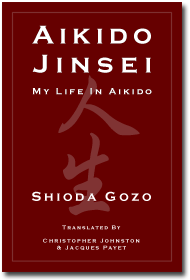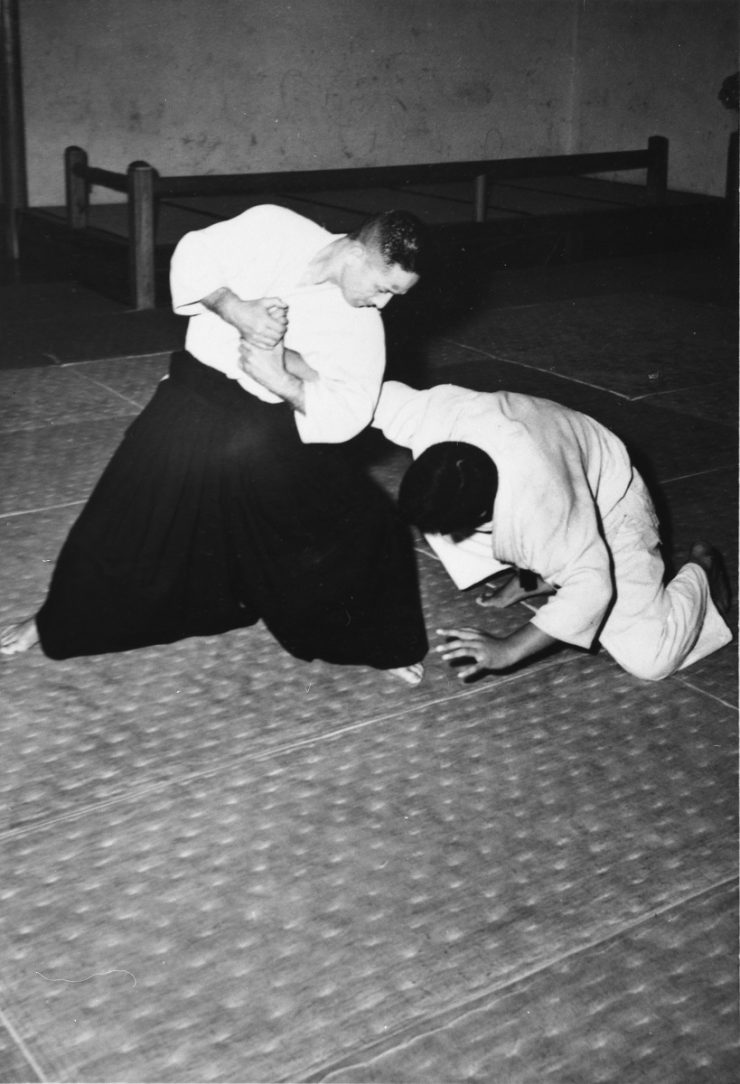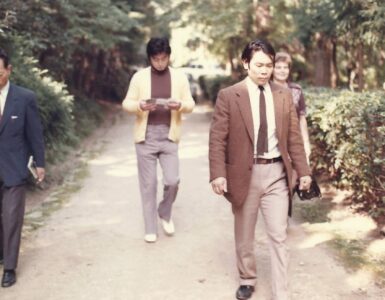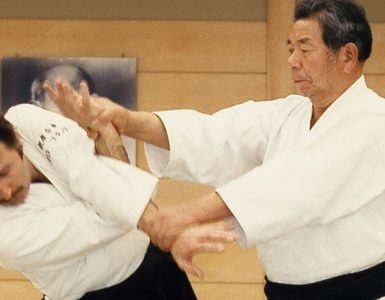From Aiki News #72 (September 1986)
Gozo Shioda began his aikido training under Morihei Ueshiba in 1932, enrolling as an uchideshi. After serving in various administrative positions during the Second World War, Shioda returned to Japan in 1946 and began teaching aikido in 1950. Five years later, he founded Yoshinkan Aikido, named his style after his father’s judo dojo. The following chapters from Aikido Jinsei (An Aikido Life), the autobiography of Gozo Shioda Sensei, are reproduced with the kind permission of the author and the publisher, Takeuchi Shoten Shinsha.
Book One: Yoshinkan Aikido
Chapter 1: The Basics of Yoshinkan Practice

The name of my dojo, “Yoshinkan,” is the same one my father, who loved budo, used when he built a dojo on his property. I have continued using that name ever since in his memory. Mr. Todo Kato, my grandfather on my mother’s side, took this name from the characters contained in the phrase “Gu o mamori kokorozashi o utsusazu mokumoku toshite sono kami o yashinau” (Cultivate your spirit silently never forgetting that you are but a fool) of the poem entitled “Saikontan.” That is the origin of the name.
I often hear people say that the Yoshinkan Dojo is a rough school. I believe there is a misunderstanding concerning this point. Among those who practice aikido there are those who wish to master the art, or to develop their minds and bodies through aikido, and also those who want to practice just to improve their health. There are young men and women, children and also elderly people. But in all cases, students of the Yoshinkan have to practice repeatedly in order to master the basics of aikido. They may use muscles they have not used for a long time or discover body movements they have never done before. Such people may experience a little pain until they get used to all these things. However, aikido without correct basics is not aikido. If you practice haphazardly just because it seems easier that way, you will not succeed in improving your techniques or your health. Since it is impossible to exaggerate the point that basics are what aikido is all about, we are strict in our instruction even of beginners in order to allow them to acquire basic technique from the outset.
It is important for those who wish to become experts or perfect their aikido to acquire a total mastery of basics. When you take a stance against an opponent, apply techniques or maintain your focus of attention after a technique (zanshin), these skills are all built on an understanding of basics and are necessary in order to defeat a strong opponent. I will explain later what aikido basics are, but for now suffice it to say that as you become experienced, you will be able to produce surprising force even in quick movements if you have naturally mastered basics.
Ueshiba O-Sensei said, “In aikido winners and losers are decided in a flash.” It is indeed so. Unless you overcome your opponent with a single blow, you cannot call your art a “budo.” Only when you adhere to basics can you defeat your opponent with a single blow.
Chapter 2: Cultivation of real skill has nothing to do with fighting in competition

There is no form of competition in aikido. We execute techniques and take falls in turn while practicing repetitively. Because of this some young people feel dissatisfied and complain that they cannot measure their improvement without competition. They may feel this way particularly because of the extreme popularity of sports and are used to situations where winners and losers are decided through competitions. In sports there are certain agreed-upon rules. This is why competitions are held and winners and losers can be determined. However, aikido is not a sport but a budo. Either you defeat your opponent or he defeats you. You cannot complain that he did not follow the rules. You have to overcome your opponent in a way appropriate to each situation.
I often hear people say that the Yoshinkan Dojo is a rough school. I believe there is a misunderstanding concerning this point. Among those who practice aikido there are those who wish to master the art, or to develop their minds and bodies through aikido, and also those who want to practice just to improve their health. There are young men and women, children and also elderly people. But in all cases, students of the Yoshinkan have to practice repeatedly in order to master the basics of aikido.
When I was young I knew my skill level to some extent through practice and demonstrations. Since I merely believed in myself and tried to hone my skills naturally through training, I once doubted if I could really handle an actual fighting situation. One day I found myself in a situation that made me realize the wonderful effectiveness of the aikido I had been practicing and made me thankful I had begun. From then on I felt a confidence spring forth. Let me recount the incident for you.
It was in July, 1941 about five months before Japan declared war on the United States. I was 26 years old then. Shunroku Hata, an army general, was a close friend of my father and treated me with affection. He was supreme commander of the expeditionary force to China. He brought me over to Beijing as his private secretary. I stopped over at the Shanghai airport for a rest on the way to Hanoi on the order of the General. While wandering about the airport I happened to run into one of my juniors from Takushoku University, a man named Uraoka. We embraced each other and jumped up and down with joy. Since I write about this encounter in the second section I won’t go into detail here.
It is at this point that we get into our story. Uraoka told me he would take me to a high-class spot in the French settlement. With my heart aflutter I followed him to a certain establishment at around 8 o’clock in the evening. After we were shown to a room, Uraoka started negotiating with a man who looked like a tout and a quarrel broke out. My junior punched the man in the face. His mouth started bleeding and he ran away shouting. I didn’t understand what was happening and stood there like an idiot. Uraoka, frowning, shouted at me.
It is important for those who wish to become experts or perfect their aikido to acquire a total mastery of basics. When you take a stance against an opponent, apply techniques or maintain your focus of attention after a technique (zanshin), these skills are all built on an understanding of basics and are necessary in order to defeat a strong opponent.
“Shioda, we will be dead in two or three minutes. He will be back for sure with his buddies to take revenge on us. Please get ready quick!”
I suggested that we run away.
“No way! We would be killed while escaping. We won’t be able to move from here until tomorrow morning,” he answered, apparently prepared to face death judging from the expression on his face.
I felt miserable thinking that I would be killed in such a place in Shanghai at the age of 26. Yet at the same time I felt a strength swelling inside of me in preparation for the fight for life to come. We were in a desperate situation.
Uraoka carried a gun because of his job, but I was without any weapon to protect myself. I looked around and found an empty beer bottle. I took a stance with the intention of knocking our attackers down with one strike using the bottle as soon as the door opened. The tense atmosphere continued. I don’t know how much time actually passed but it seemed an eternity. Having grown impatient, I told Uraoka that no one was coming. However, he repeated that they would definitely come.
It was late at night, perhaps around two in the morning, when we finally heard them. It sounded like there were four or five men. I stood against the wall and adopted a fighting stance. Then I started shaking. I tried to stop but I couldn’t. It was somehow different from trembling with excitement.
I opened the door a little thinking I would get the jump on them. I was planning to pull the door open the moment they touched it and knock them down as they stumbled into the room. Uraoka was pointing his pistol at the center of the door in the lightless room.
Suddenly their footsteps stopped outside the door for a moment. When I peaked through the opening I saw them sneaking towards the room in little steps.
I felt miserable thinking that I would be killed in such a place in Shanghai at the age of 26. Yet at the same time I felt a strength swelling inside of me in preparation for the fight for life to come. We were in a desperate situation.
When I jerked open the door at just the right time, one of the men, who seemed to have been caught off guard by this maneuver, fell forward into the room. I hit him on the head with the beer bottle. The bottle broke and I saw the jagged remainder in my hand notched like the teeth of shark. I pushed it forward into the man’s face all at once and twisted. It caught him squarely. The pain must have been unbearable. Blood gushed out and he threw himself back immediately. I pulled him back into the room to prevent his escape. It all happened in a instant.
There were still three men left. Then, a big Chinese man came to kick me. I opened my body to the left and slapped down his kicking leg with my right hand while turning my back to him. I just hit his leg naturally without using much strength and he lost control and fell. I learned later that his knee joint and bones were broken.
Having easily taken care of two of the men, I became to feel somewhat calmer. However, as soon as I regained my composure, another man punched at my face. I evaded his punch with an inward turn and applied a variation of shihonage grabbing his hand from underneath. I then put his elbow on my shoulder and applied a decisive pressure and the man fell. His elbow snapped easier than what one might suspect and he flew forward. I handled three men and I don’t think the whole struggle lasted for more than a minute. I tied up the three stunned men with my belt and calmly looked up.
It was late at night, perhaps around two in the morning, when we finally heard them. It sounded like there were four or five men. I stood against the wall and adopted a fighting stance. Then I started shaking. I tried to stop but I couldn’t. It was somehow different from trembling with excitement.
I saw Uraoka struggling against the last man. He had a fourth dan in judo and was quite skilled at martial arts. His way of fighting was really great. But even though he threw the last attacker with beautiful hanegoshi and uchimata, he was getting up to attack again and again because Uraoka did not apply any decisive technique. Thus he could not easily end the fight and continued struggling. I thought I would test how effective aikido atemi was and told my companion to let me take care of the man. When he got up again after being thrown by Uraoka he came to attack and I executed an atemi to his ribs. He groaned frothing at the mouth and fell backward.
I was able to see the results of my daily aikido training because I was put into a life-or-death situation against my will. However, those practicing aikido should definitely avoid provoking quarrels or attempting to seek out situations to test their own strength. It is not necessary to resort to such acts to develop one’s skill as long as one continues to practice according to aikido principles with a pure mind. The beauty of balance will permeate through him, his form and his movements. This is obvious at a single glance.













Thank you for offering these articles about Shioda Gozo Soke and the Yoshinkai branch of Aikido. It is nice to see that the Yoshinkai branch of Aikido has not been completely ignored by the Aiki dominated Aikido world. Yoshinkai Aikido is alive and well in many places, especially Canada, where our federation is based. Unfortunately we are not well accepted by some Aikido elitists who look down their nose at us and most Aikido practitioners are rather uninformed about us. As Shioda Gozo Soke was a major contributor to the growth of Aikido, I believe that it is important to understand and appreciate his part of the evolution of the art. As a direct student of Shioda Gozo Soke and life-long practitioner of Aikido, I can attest to the powerful and awe-inspiring capabilities of him as a teacher and man. His Aikido and his examples of life lessons will be with me forever and I do my humble best to share them to the best of my ability. Thank you again for highlighting this amazing man and acknowledging the Yoshinkai style of Aikido as a direct link to Ueshiba O-Sensei. Aikido is about harmony and I think the world needs more of that in every form possible. OSU!
Kevin Blok
The primary sponsor of the production of this book was Geordan Reynolds Sensei. I’ve been unable to reach him for the last month. I’d like to know if he is okay.
I would like to appeal to the Aikido Yoshinkai Foundation to open Aikido Yoshinkan dojos in Portugal, in the cities of Porto and Lisbon.
Unfortunately, Aikido Aikikai only exists in Portugal, which means that those who have a different view of this Martial Art, focused on self-defense, effectiveness of techniques, and physical training, do not practice Aikido and are led to practice the Aikikai style despite upset because they have no alternative.